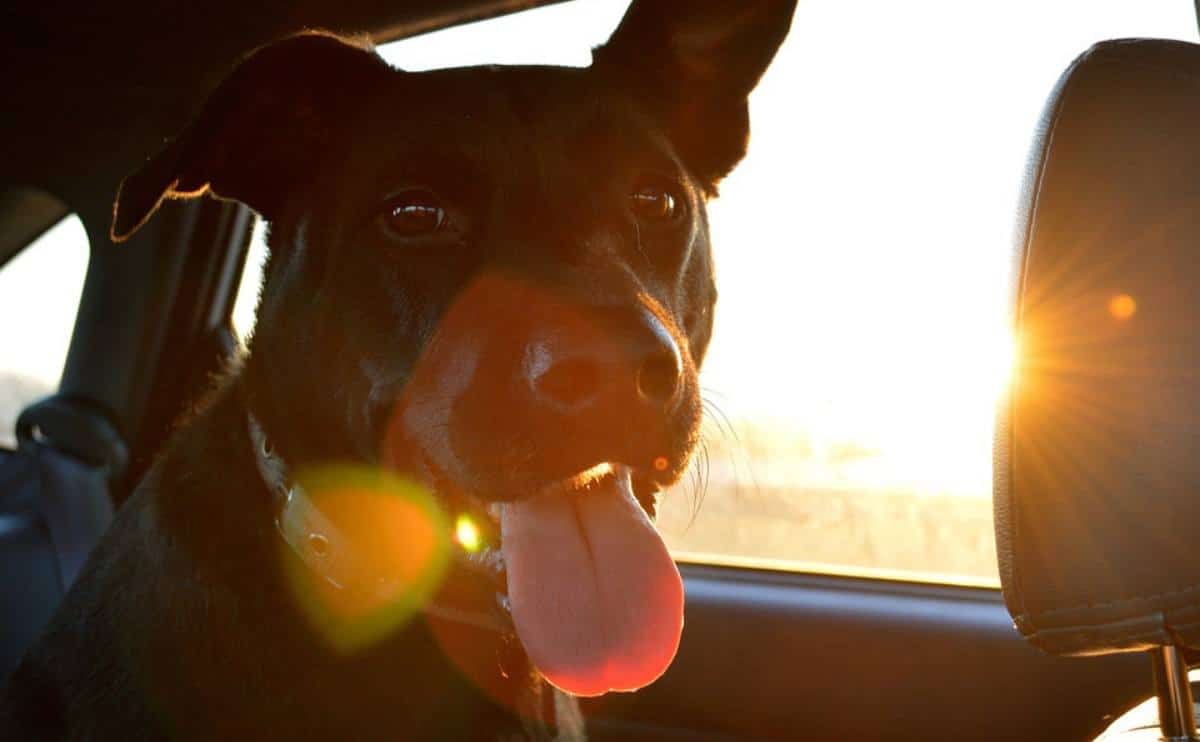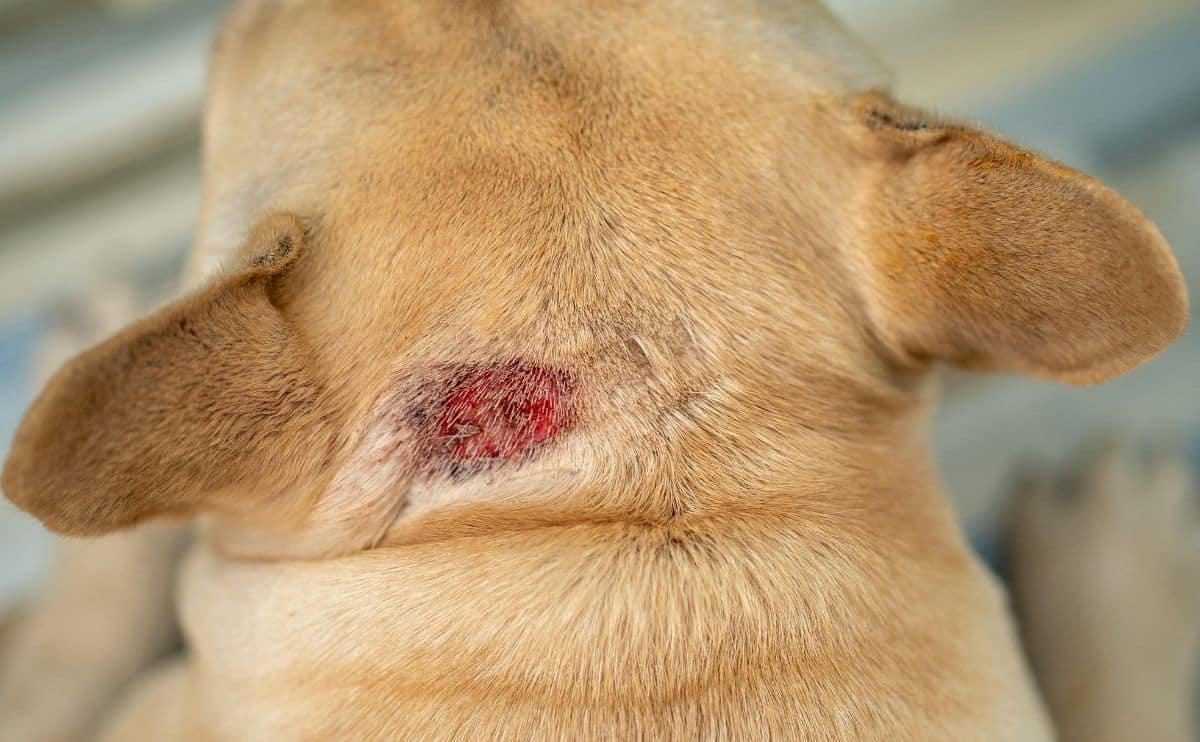Help! My Dog Is Unsteady & Wobbly: 9 Reasons Your Dog Is Stumbling, Falling Over & Losing Balance
When you purchase through links on our site, we may earn a commission. Here’s how it works.

If your dog suddenly starts having trouble keeping its balance, walking sideways, or even falls over, it’s more than just a little concern—it can be downright scary for us dog parents. Watching your furry friend wobble or act disoriented might leave you wondering what’s happening and whether you should worry. The truth is a variety of issues could be causing these troubling symptoms, and some of them are more serious than you might think.
Table of Contents
Note: if your dog can’t get up, that’s an entirely separate issue that we’ve written about to help you understand what may be going on with your dog.
9 Reasons Dogs Become Wobbly And Lose Balance
“In clinics, I see many different disease processes that can cause a dog to become ataxic (uncoordinated) or lose their balance, some easier to treat than others,” says Dr. Rebecca MacMillan, BVetMed BSAVA PGCertSAM MRCVS. “A condition may affect your dog’s brain and inner ear, affecting their balance directly, or it could be caused by muscle weakness or nerve problems in the limbs or spine.”
In the following sections, I’ll walk you through some of the most common reasons dogs struggle with balance and when to stop guessing and take action. If you notice your dog acting wobbly, falling over, or unable to walk straight, it’s essential to pay attention and seek advice from a professional.
Don’t wait it out! If your dog seems off balance or disoriented, quickly reaching out to the vet can make all the difference. While some causes are minor, many indicate a deeper issue that requires prompt attention. Most likely, it’s not something you can treat on your own, and the sooner you get expert help, the better the chances for your pet’s full recovery.
1. Degenerative Myelopathy

Degenerative Myelopathy (DM) is a progressive and debilitating spinal cord disease that primarily affects older dogs, particularly breeds such as German Shepherds, Boxers, and Corgis. This condition, caused by a genetic mutation, gradually degenerates the spinal cord’s nerve fibers. The disease closely resembles amyotrophic lateral sclerosis (ALS) in humans, often referred to as Lou Gehrig’s disease. While the condition is not fully understood, it presents unique challenges for dog owners, as it gradually impairs mobility and quality of life.
Signs & Symptoms
The onset of DM is subtle, with dogs often showing mild signs of hind limb weakness and difficulty with coordination. One of the earliest symptoms may include dragging the rear paws or stumbling while walking, particularly in the back legs. As the disease progresses, dogs may struggle to stand or walk, often exhibiting signs of balance loss and unsteadiness. In more advanced stages, the disease can lead to complete paralysis in the hind limbs, and eventually, the front limbs and respiratory muscles may also be affected.
Diagnosis
Because DM’s symptoms can resemble those of other conditions, a thorough and careful diagnosis is essential. Veterinarians typically begin by assessing clinical signs, reviewing the dog’s breed history, and conducting genetic testing to confirm the presence of the specific mutation associated with DM. Since conditions like arthritis, herniated discs, or tumors can present with similar symptoms, it’s important to rule these out before reaching a diagnosis.
Advanced diagnostic tools, such as MRI scans and spinal fluid analysis, may be used to confirm spinal cord degeneration further. These tests help veterinarians visualize any changes or abnormalities in the spinal cord that suggest the presence of DM. A definitive diagnosis often requires a combination of genetic testing and ruling out other possible causes of the symptoms.
Treatment & Management
Currently, there is no cure for Degenerative Myelopathy. However, while the disease is progressive and ultimately fatal, several ways exist to manage the condition and improve a dog’s quality of life. Physical therapy, including targeted exercises and hydrotherapy, can help maintain mobility and slow the progression of the disease. These therapies focus on strengthening muscles, enhancing flexibility, and improving circulation, which can provide much-needed relief and maintain some level of function for as long as possible.
Mobility aids, such as dog wheelchairs, harnesses, and ramps, are also commonly used to assist dogs as they lose their ability to walk. These devices support and allow dogs to remain active and mobile, even as their disease progresses. Additionally, anti-inflammatory supplements—such as fish oil and CBD—may help reduce inflammation and support nerve health, offering some relief from the debilitating symptoms of DM.
Prognosis & Quality Of Life
Degenerative Myelopathy is a progressive disease, and unfortunately, there is no way to halt or reverse the damage to the spinal cord. In most cases, dogs experience complete paralysis within 6 to 12 months of the onset of symptoms. Assistive devices, physical therapy, and a supportive environment can help dogs maintain a good quality of life, providing comfort and support as the disease progresses.
While the prognosis for dogs with DM is ultimately grim, the focus of care shifts to maximizing the dog’s comfort and well-being. With dedication and love, many owners find that their dogs can continue to enjoy life surrounded by the support and compassion they deserve.
2. Ear Infections
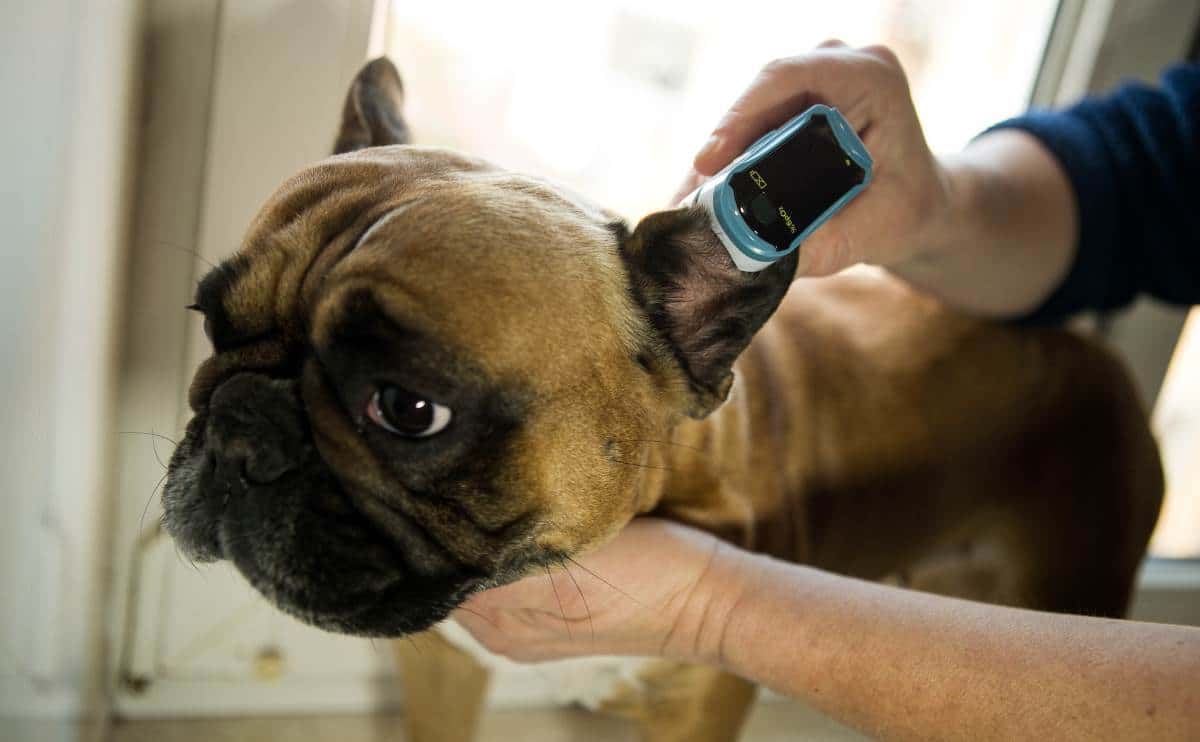
Ear infections are common in dogs, but when they affect the middle or inner ear, they can seriously impact balance and coordination. These infections are often caused by bacteria, yeast, parasites (like ear mites), foreign objects, or allergies. Chronic infections can spread deeper into the ear and affect the vestibular system, leading to balance problems.
Causes & Symptoms
Ear infections in dogs can result from various factors. Common symptoms include head shaking, ear scratching, redness, swelling, discharge (yellow, brown, or black), a foul odor, and sensitivity to touch. As the infection progresses, especially to the inner ear, you may notice a head tilt, rapid eye movements (nystagmus), difficulty walking, and disorientation.
Diagnosis
Veterinarians typically diagnose ear infections through a physical exam and otoscopic inspection, looking for inflammation, debris, or foreign objects. A swab may be taken to identify whether the infection is bacterial, fungal, or parasitic. Advanced imaging, such as X-rays, CT scans, or MRIs, may be necessary if the infection has spread to the middle or inner ear.
Treatment
The treatment for ear infections in dogs depends on the severity and cause of the infection. For external ear infections, your vet may prescribe topical ear drops that contain antibiotics or antifungal medications to target the specific pathogen. Oral antibiotics may be required for bacterial infections, while antifungal medications will be used for fungal infections.
More extensive treatment may be necessary if the infection has progressed to the inner ear. Long-term medication may be needed to clear the infection; in some cases, surgical intervention could be required to remove debris or infected tissue. Your vet may also recommend regular ear cleaning as part of the treatment to keep the ear canal free from irritants and prevent further infections.
Recovery
Recovery time varies depending on the infection’s severity. Mild infections typically improve within 1-2 weeks, but deeper infections, especially those affecting the inner ear, may require 4-6 weeks of treatment. During this time, monitoring your dog for signs of recurrence is essential, as chronic infections can lead to permanent damage, especially in the vestibular system, affecting balance. Proper care and following your vet’s recommendations are crucial to ensuring a full recovery and preventing future ear issues.
3. Heart Disease & Syncope
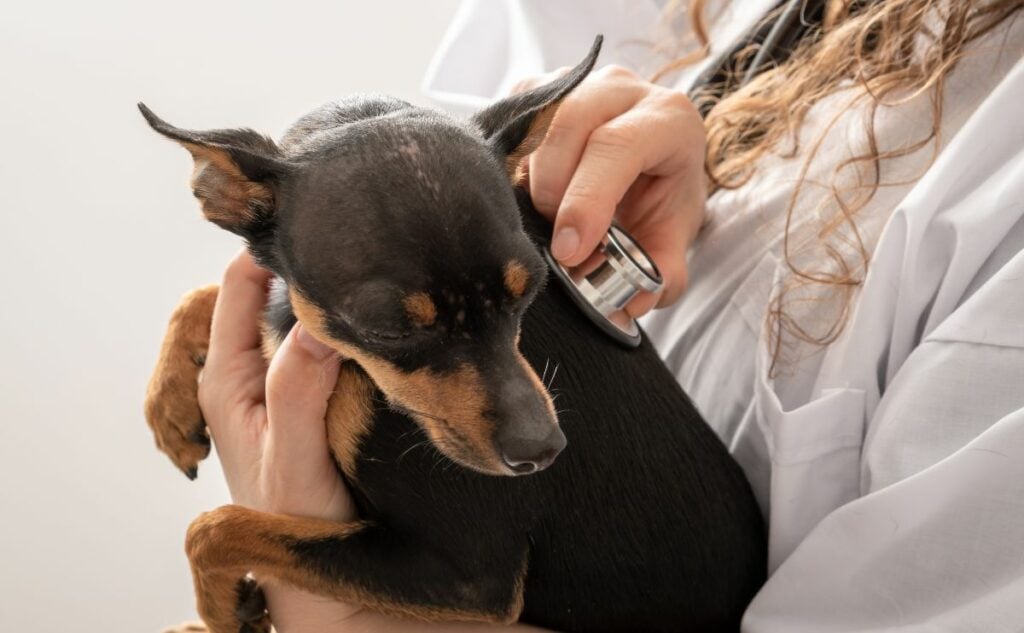
Heart disease in dogs can lead to syncope (fainting), often mistaken for a loss of balance. Conditions such as heart failure, arrhythmias (irregular heartbeats), and heart valve disease can impair blood flow to the brain, causing sudden collapses.
Signs & Symptoms
Syncope often presents with symptoms such as weakness, lethargy, exercise intolerance, coughing, difficulty breathing, and fainting episodes. Dogs with severe heart disease may collapse after excitement, exercise, or stress. If you notice your dog coughing and then suddenly falling over, it could be a sign of syncope caused by a lack of oxygen or glucose reaching the brain.
Diagnosis
A veterinarian will typically perform a thorough examination to diagnose the underlying cause of syncope. This includes auscultation (listening to the heart) to detect irregular heartbeats and imaging tests like X-rays and echocardiograms to evaluate heart function. Electrocardiograms (ECG) can also help assess the heart’s electrical activity. Blood tests may be conducted to check for additional conditions, such as heartworm disease or low oxygen levels.
Treatment & Management
Treatment depends on the specific heart condition diagnosed. For heart disease, medications may include:
- Diuretics to reduce fluid buildup
- Beta-blockers to control heart rate and prevent arrhythmias
- ACE inhibitors to improve circulation and ease the heart’s workload
Your vet may prescribe an antiparasitic treatment if heartworm disease is identified as the cause. The goal is to manage the heart condition, reduce symptoms, and improve quality of life. Some dogs respond well to medications and can live comfortably, while others may require lifelong management.
Prognosis & Quality Of Life
The prognosis for dogs with heart disease varies. Some dogs respond positively to medication and can live comfortably with regular veterinary check-ups. However, heart disease can be progressive, and ongoing management may be required to control symptoms. Regularly monitoring your dog’s heart function is crucial to ensure they receive the appropriate care and adjustments to their treatment plan.
Syncope vs Seizures
Due to similar symptoms, syncope is often confused with seizures. However, if coughing triggers the event, it is more likely to be syncope than a seizure. Syncope episodes typically last only a few seconds to minutes and are linked to a temporary lack of blood flow to the brain.
Dogs that experience syncope may have recurrent episodes, which can become more severe over time. If you notice your dog is coughing and collapsing, it’s important to consult with your vet to determine the underlying cause and begin appropriate treatment.
4. Hypoglycemia (Low Blood Sugar)

Hypoglycemia occurs when blood sugar levels drop too low, affecting brain function and causing weakness and loss of coordination. It is most common in small-breed puppies, diabetic dogs on insulin, and dogs with liver disease or tumors that disrupt glucose metabolism.
Signs & Symptoms
Common symptoms include weakness, disorientation, shaking, muscle twitching, and collapsing. In severe cases, dogs may experience seizures or fall into a coma. Puppies with hypoglycemia often appear lethargic, struggle to stand, and seem confused.
Diagnosis
A vet will diagnose hypoglycemia through a blood glucose test and evaluate potential underlying causes, such as diabetes, liver disease, or tumors. Persistent cases may require additional bloodwork and imaging, such as an abdominal ultrasound, to identify the root cause.
Treatment & Management
If the dog is conscious, sugar sources like honey, corn syrup, or glucose gel can help raise blood sugar levels. Severe cases require immediate veterinary care, where intravenous glucose is administered. Long-term management addresses the underlying condition, such as adjusting insulin doses in diabetic dogs or treating liver disease.
Prognosis & Quality Of Life
Recovery depends on the cause. Puppies typically outgrow hypoglycemia with proper nutrition, while diabetic dogs need careful monitoring and insulin adjustments to prevent recurrences. With appropriate treatment, most dogs can manage hypoglycemia effectively and maintain a good quality of life.
5. Neurological Disorders
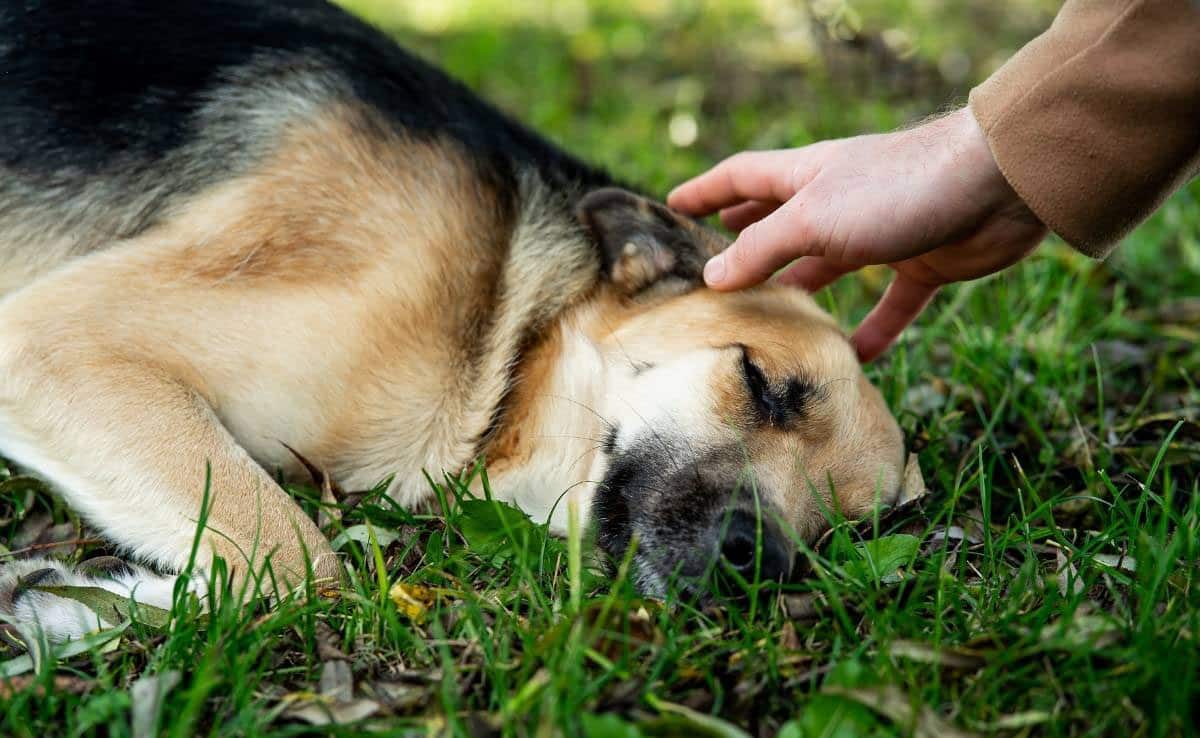
Neurological disorders in dogs can significantly impact their balance by affecting key areas of the nervous system, such as the brainstem, cerebellum, or spinal cord. These issues can arise from a variety of causes. Such conditions may lead to symptoms such as uncoordinated movements, disorientation, and difficulty with posture, highlighting the importance of early diagnosis and intervention for optimal management and care.
Types Of Ataxia
Ataxia is a general term used to describe a lack of coordination or unsteady movements. While ataxia can be a symptom of certain diseases, it can also refer to a group of diseases that cause dysfunction in the nervous system.
Ataxia occurs when the brain, spinal cord, or peripheral nerves are impaired, particularly in areas that control muscle coordination, such as the cerebellum. In dogs, ataxia can result from a variety of causes, including neurological disorders like brain tumors, infections, strokes, or degenerative diseases, and it often manifests as staggering, difficulty walking, or a lack of balance.
3 Types Of Ataxia:
- Spinal Cord Ataxia: Caused by spinal cord compression due to a bulging disc, tumor, trauma, or narrowing of the spinal canal. Symptoms include staggering, balance loss, nausea, vomiting, and abnormal eye movement.
- Cerebellar Ataxia: Results from brain tumors, strokes, infections, or degenerative conditions affecting the cerebellum. Dogs show exaggerated movements, head tremors, and severe coordination loss.
- Vestibular Ataxia: Affects the inner ear or brainstem, causing dizziness, a drunken gait, falling over, and rolling. It often occurs in older dogs and may result from infections, inflammation, tumors, or toxins.
Signs & Symptoms
Symptoms of neurological disorders vary depending on the condition:
- Brain tumors: Gradual loss of coordination, seizures, head tilt, and behavioral changes
- Encephalitis (brain inflammation): Fever, lethargy, muscle weakness, disorientation, seizures, and head tremors
- Seizures: Stiffening, collapsing, uncontrolled shaking, and temporary loss of consciousness
- Stroke: Sudden weakness, head tilt, falling over, confusion, and abnormal eye movements
Diagnosis
Veterinarians diagnose neurological disorders through:
- Physical & Neurological Exams: Evaluates reflexes, coordination, and muscle strength
- Imaging (MRI, CT Scan, X-rays): Identifies strokes, tumors, spinal cord compression, or brain inflammation
- Blood Tests & CSF Analysis: Detects infections, immune disorders, and metabolic issues
Treatment & Management
Treatment depends on the underlying cause:
- Ataxia: Supportive care, physical therapy, and treating the primary cause
- Brain tumors: Surgery, radiation, or chemotherapy
- Encephalitis: Anti-inflammatory drugs, antibiotics, or antifungal medications if an infection is present
- Seizures: Anti-seizure medication for long-term management
- Stroke: Medications to regulate blood pressure and prevent clotting
Prognosis & Quality Of Life
Recovery varies based on the severity of the condition. Some dogs regain balance and coordination with treatment and therapy, while others may have lasting neurological deficits. Supportive care, regular veterinary check-ups, and medications can improve a dog’s quality of life.
If your dog experiences sudden balance loss, seizures, or unusual behavior, consult a veterinarian immediately for an accurate diagnosis and appropriate treatment.
6. Poisoning Or Toxins

Certain toxins can severely impact a dog’s nervous system, leading to loss of balance, tremors, seizures, and even life-threatening complications. Common toxins include household chemicals, medications, rodenticides, insecticides, poisonous plants, and certain foods. Quick identification and treatment are crucial to minimize damage and improve recovery outcomes.
Signs & Symptoms
The symptoms of toxin ingestion in dogs can vary depending on the type and amount of toxin consumed, but they generally progress in stages. Early signs often include vomiting, drooling, diarrhea, lethargy, and loss of coordination. As the effects of the toxin worsen, neurological symptoms such as tremors, seizures, muscle twitching, confusion, an unsteady gait, and even collapse may appear. In severe cases, the situation can become life-threatening, leading to respiratory distress, irregular heart rate, paralysis, coma, or even death, highlighting the importance of prompt veterinary care in cases of suspected poisoning.
Common Toxins & Their Effects
- Antifreeze (ethylene glycol): Causes severe kidney damage, lethargy, vomiting, seizures, and coma.
- Human medications (Ibuprofen, antidepressants, ADHD medications): Can lead to tremors, seizures, and gastrointestinal issues
- Rodenticides (rat poison): Some types cause internal bleeding, while others affect the nervous system, leading to tremors and seizures
- Insecticides (organophosphates, pyrethrins): Can cause excessive drooling, muscle twitching, and seizures
- Toxic plants: Affect the nervous system, heart, or liver, leading to tremors, vomiting, and organ failure.
- Foods (xylitol, chocolate, grapes/raisins): Xylitol causes dangerous drops in blood sugar and liver failure. Chocolate can trigger tremors, seizures, and heart arrhythmias. Grapes may lead to acute kidney injury in some dogs.
Diagnosis
Diagnosing toxin exposure in dogs requires a comprehensive approach, starting with a thorough medical history, physical examination, and laboratory tests. One of the first key steps is identifying potential toxin exposure, so owners should provide details about any possible ingestion, such as household items, medications, or plants. Blood tests and urinalysis are important for detecting organ damage, abnormalities in blood sugar levels, or the presence of specific toxins.
In certain cases, specialized testing may be necessary, such as specific tests for toxins like antifreeze. Additionally, imaging techniques like X-rays or ultrasound may be used to identify ingested foreign substances, helping to guide the diagnosis and treatment.
Treatment
Treatment for toxin exposure in dogs depends on the specific toxin involved but generally follows several key approaches. If the ingestion is recent, decontamination is a priority. Veterinarians may induce vomiting to expel the toxin, although they avoid this for caustic substances that could cause further damage. They often administer activated charcoal to absorb toxins in the gastrointestinal tract and prevent their absorption into the bloodstream.
Supportive care is also essential in managing toxin exposure. Intravenous (IV) fluids are commonly given to help flush toxins from the body and support organ function. At the same time, oxygen therapy may be needed in severe cases to ensure proper respiratory function.
Veterinarians tailor medications to address specific symptoms and toxins. For example, they may prescribe anticonvulsants like diazepam or phenobarbital if the dog is experiencing seizures. Some toxins, such as antifreeze, have specific antidotes like fomepizole, while others, such as certain rodenticides, require treatment with vitamin K. Gastrointestinal protection is also an essential aspect of treatment, with anti-nausea medications and stomach protectants provided to help manage symptoms.
In severe cases, hospitalization may be required for respiratory support or intensive care, depending on the extent of the poisoning and the urgency of the treatment needed.
Recovery
Your dog’s recovery from toxin exposure depends on several factors, including the type of toxin, the amount ingested, and how quickly treatment is administered. In mild cases, many dogs can fully recover within a few days with prompt treatment. However, moderate to severe cases may result in lasting neurological or organ damage, which requires long-term management and follow-up care.
Some toxins, such as antifreeze or certain mushrooms, can be deadly if not treated immediately, underscoring the importance of rapid intervention to improve the chances of survival.
Prevention Tips
- Store household chemicals safely: Keep antifreeze, rodenticides, and medications out of reach
- Monitor outdoor exposure: Prevent access to toxic plants and unknown substances on walks
- Avoid feeding dangerous foods: Never give dogs chocolate, xylitol-containing products, grapes, or raisins
If you suspect your dog has ingested a toxin, seek emergency veterinary care immediately. Early treatment is critical for the best possible outcome.
7. Trauma Or Injury
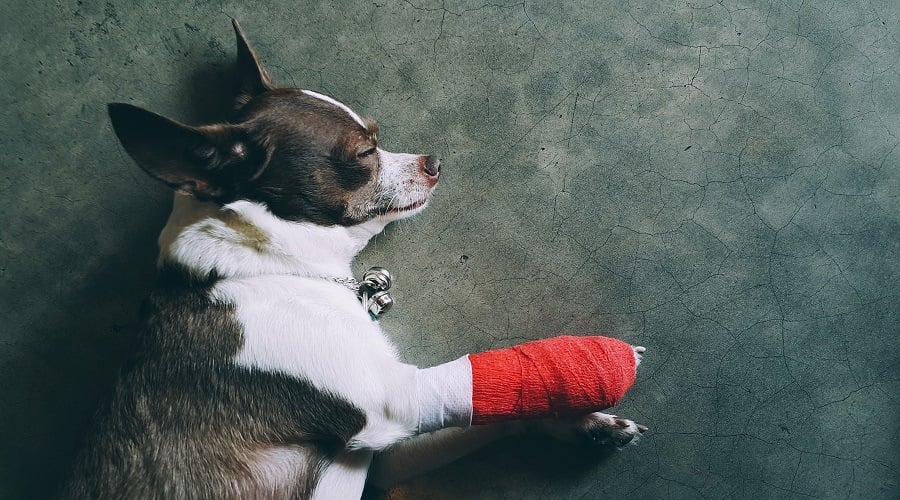
Head trauma or spinal injuries can cause sudden balance loss, disorientation, and difficulty walking. A fall, car accident, rough play, or being struck on the head can cause trauma.
Head trauma requires a visit to the vet right away. You may notice your dog walking around in circles, falling down, or losing control of their body’s movements. This is a sign of a dysfunction in the brain, affecting motor control.
Signs & Symptoms
Symptoms include staggering, head tilt, abnormal eye movements, lethargy, confusion, seizures, and, in severe cases, loss of consciousness. Dogs with spinal injuries may also show signs of weakness or paralysis.
Diagnosis
Diagnosis involves a neurological exam, X-rays, CT scans, or MRIs to assess brain and spinal cord damage. If there is internal bleeding or swelling, immediate intervention is needed.
Treatment & Management
Treatment depends on severity. Mild concussions may require rest and monitoring, while severe injuries may need surgery, anti-inflammatory drugs, or physical therapy. If brain swelling occurs, oxygen therapy and IV fluids may be necessary.
Traumatic brain injury can come from head trauma, and if it is not treated, it can be very serious and even fatal. If your dog has experienced a head trauma or you suspect one, you should take them to the emergency vet right away.
Recovery
Recovery varies. Mild injuries often heal within weeks, while severe trauma may lead to permanent neurological deficits. Dogs recovering from spinal injuries may require long-term rehabilitation and mobility support.
8. Vestibular Disease (Canine Vestibular Syndrome)

“The most common [condition] I see is idiopathic vestibular disease (or idiopathic vestibular syndrome),” says MacMillan. ” It affects the balance center in the inner ear, which is known as the vestibular system.”
Vestibular disease can be idiopathic (no known cause) or due to inner ear infections, inflammation, brain tumors, strokes, or toxins. The idiopathic form, often called “Old Dog Vestibular Disease,” is most common in older dogs and appears suddenly. While the condition can be alarming, it is not usually life-threatening.
“Vets understand that this condition can look quite alarming, with many owners concerned that their pet has suffered from a stroke,” says MacMillan. “In most cases, I see improvement within a few days and are back to normal again within a week or two. Very occasionally the dog is left with a permanent head tilt and mild ataxia, but they seem to adapt well to this and can still lead a happy life. I always make owners aware that these dogs can have more than one vestibular episode in their lifetime.”
Signs & Symptoms
Dogs with vestibular disease typically exhibit a sudden loss of balance, head tilt, rapid eye movements (nystagmus), difficulty standing, and nausea due to dizziness. Some may struggle to walk, fall over, or circle continuously. The severity of symptoms varies, but many dogs experience disorientation and distress.
6 Symptoms:
- A dog falling over as if drunk or acting drunk and wobbly
- Unsteady on feet suddenly, or the dog is wobbly and off-balance
- Falling to one side
- Dog walking sideways
- Dog losing balance in hind legs
- Dog stumbling on front legs
Diagnosis
A veterinarian will diagnose vestibular disease through a physical examination, neurological tests, and imaging like X-rays, CT scans, or MRIs to rule out tumors or strokes. Blood tests may also help identify underlying infections or metabolic disorders.
Treatment & Management
Treatment depends on the cause. Idiopathic vestibular disease often resolves on its own within a few weeks with supportive care, including anti-nausea medication and fluids if the dog cannot eat. If an infection is present, antibiotics or antifungal medications may be prescribed. For severe cases, hospitalization may be needed.
Recovery
Recovery varies. Most dogs with idiopathic vestibular disease improve within 2-3 weeks, although some may retain a slight head tilt. If caused by an infection or tumor, recovery depends on treatment success. Owners should provide a safe, quiet space and assist their dog with mobility during recovery.
9. Wobbler Syndrome (Cervical Spondylomyelopathy)

Wobbler Syndrome is a spinal condition affecting the vertebrae in the neck, primarily seen in large and giant dog breeds like Dobermans, Great Danes, and Mastiffs. It results from vertebral malformations or spinal cord compression, leading to weakness and loss of coordination, particularly in the hind legs. Causes include genetics, rapid growth, and disc degeneration.
Signs & Symptoms
Dogs with Wobbler Syndrome often exhibit an unsteady, wobbly gait, difficulty standing, weakness in the hind limbs, and reluctance to move the neck. In severe cases, they may become unable to walk entirely. Symptoms progress gradually and may worsen over time.
Diagnosis
Diagnosis involves a neurological examination, X-rays, and advanced imaging such as MRI or CT scans to assess spinal compression. A myelogram (contrast dye injection) may also be used to visualize spinal cord issues.
Treatment & Management
Treatment depends on severity. Mild cases may be managed with anti-inflammatory medications, physical therapy, and restricted activity. Severe cases may require surgery to relieve spinal cord compression. Weight management and the use of harnesses instead of collars can help prevent worsening symptoms.
Recovery
Recovery varies. Some dogs improve with conservative management, while others may need lifelong treatment or mobility assistance. Surgical success rates are good, but rehabilitation and physical therapy are often required for full recovery.
Caring For A Dog With Balance Problems (A Vet’s Expert Opinion)
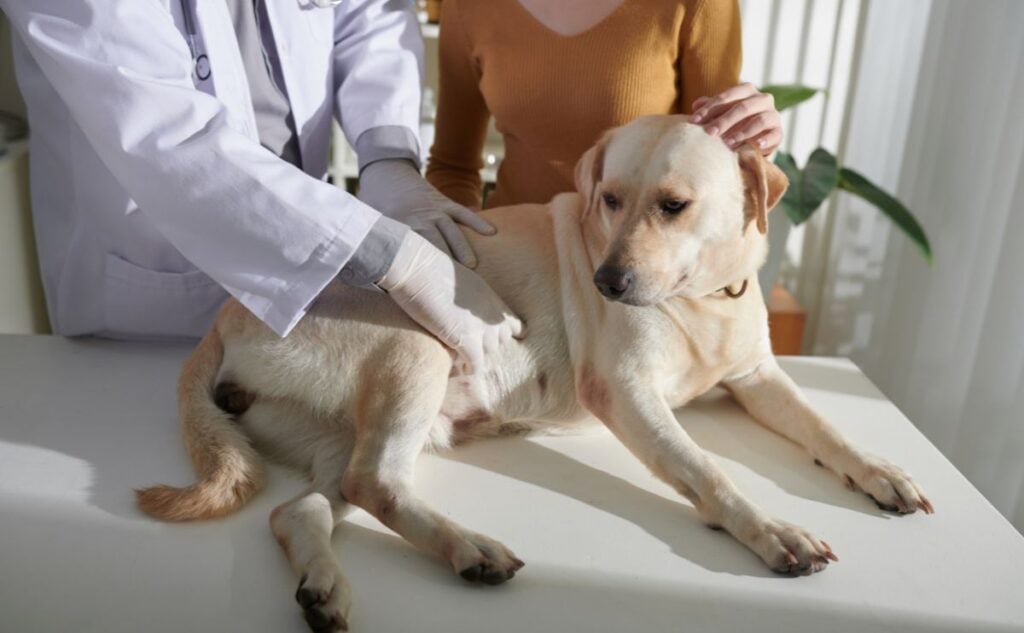
“All dogs with weakness or balance issues will benefit from a few home adaptations,” says MacMillan. “Non-slip rugs are a must for these dogs as they often struggle on surfaces like smooth tiles or laminate flooring. Rugs or carpets will allow your dog to grip more easily as they walk, avoiding injury and giving them more confidence to move around.”
MacMillan also says, “You should also ensure that your dog can easily get in and out of their bed without falling, and that access to their bowls is made easy. Some dogs may need to stay downstairs, as going up and down staircases unsupervised could result in an accident. You may need to purchase some baby gates to keep your dog in a safe area of the house.”
In severe cases, your pup may even need help using the bathroom. “Using a sling or even a large towel under their abdomen to support some of their weight can be helpful for these dogs,” says MacMillan.
Frequently Asked Questions
I know there are still plenty of questions. Below, I cover a few of the most frequently asked questions about dogs falling over, being off-balance, and having trouble walking. If I missed yours, let me know in the comments.
Why Is My Dog Falling Down Stairs?
If your dog is frequently falling down the stairs, it may be due to a simple issue like a lack of traction. Hardwood or tile stairs can be slippery, especially for older dogs or those with weak muscles. You can try adding stair runners or traction mats to improve grip. However, if you have carpeted stairs and your dog is still struggling, there may be an underlying medical condition affecting their balance or mobility.
Some common health issues that can make stair navigation difficult include arthritis, hip dysplasia, cruciate ligament tears (CCL), and other joint problems. Additionally, neurological conditions such as vestibular disease or nerve damage can cause instability, making it harder for your dog to maintain balance.
If your dog is experiencing repeated falls, schedule a veterinary visit as soon as possible to assess their health and determine appropriate treatment options.
Why Is My Dog With Cushing’s Falling Down?
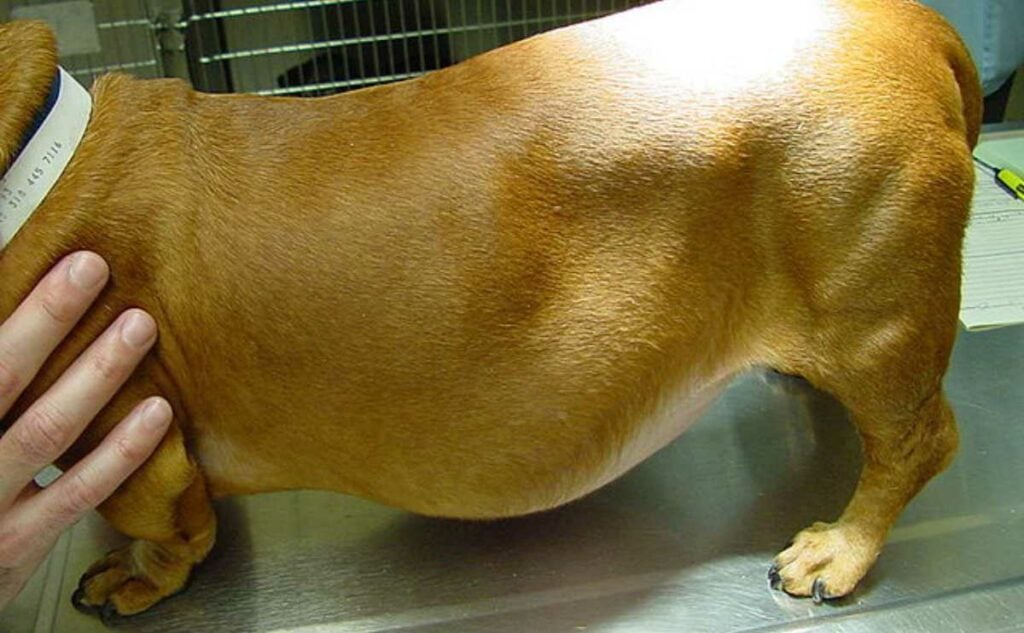
Cushing’s disease, or hyperadrenocorticism, occurs when a dog’s body produces excess cortisol, leading to a variety of symptoms. Dogs with Cushing’s often experience muscle weakness, lethargy, and coordination issues, which can increase the likelihood of falls. Additionally, the disease can cause hind leg weakness, making it harder for them to support themselves, especially on slippery surfaces or stairs.
If your dog with Cushing’s is falling more often, notify your veterinarian immediately. Managing Cushing’s disease often involves medication to regulate cortisol levels, and your vet may adjust the dosage if symptoms worsen. You can also provide supportive care at home, such as using non-slip rugs and ramps to help your dog move around safely.
Since Cushing’s can progress over time, regular vet check-ups are essential to monitor your dog’s condition and adjust their treatment plan accordingly.
Why Is My Dog Walking Sideways & Falling Over?
If your dog has started walking sideways, also known as “crabbing,” and is frequently falling over, there may be an underlying health issue affecting their coordination. Some of the most common causes include hip dysplasia, a painful condition where the hip joint is improperly formed, or vestibular disease, which affects a dog’s inner ear and balance. Neurological issues, spinal injuries, or even infections like Lyme disease can also contribute to an unsteady gait.
It’s important to observe whether your dog is showing additional symptoms such as head tilting, circling, vomiting, or difficulty standing. If their sideways walking is sudden, it could be a sign of a stroke or another urgent medical issue. Even if the symptoms develop gradually, it’s best to have a vet evaluate your dog as soon as possible.
Should I Get Pet Insurance?

Does reading this article cause you concern about your dog’s future health? Maybe he’s as fit as a fiddle right now, but did you know dogs are more likely to experience health issues as they age?
We recommend purchasing pet insurance while your dog is young, so you can have coverage for as many ailments as possible without worrying about pre-existing conditions being excluded from your coverage.
To learn more about pet insurance and determine whether it’s a good option for you, read our Pet Insurance 101 guide.
Keeping Your Dog Healthy
A nutritious diet, plenty of exercise, and regular veterinary care are important to keeping our pets healthy as long as possible. Preventative care is pivotal in identifying issues early and getting treatment. Learn more about dog life expectancy here and some tips on how to care for your senior dog.
Why Trust Canine Journal?
Danielle has shared a special bond with dogs since she was a child. She has over 30 years of pet care experience and has worked as a professional researcher for many years. She spends countless hours examining the latest science and data-backed research on pet care, health, nutrition, and training developments with the enthusiastic help of her two dogs, Daisy and Falkor. She works with a professional and experienced team to bring our readers the best, most accurate, and up-to-date information.


